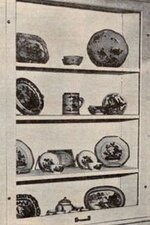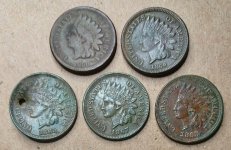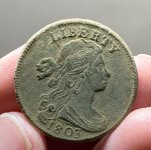Gypsy Heart
Gold Member
Newspaper article July 5 1903
http://query.nytimes.com/mem/archiv...F1F3BEE33A25756C0A9619C946297D6CF&oref=slogin
1904-
Within the last year, at Cooperstown, New York, a quantity of old porcelain has come to light. A farmer was ploughing, when suddenly the plough struck some hard substance, and a moment later there was a crash as of broken crockery. Investigation proved that he had struck a wooden chest, filled with china articles. There were eighty pieces in all, and fifty were saved in a perfect condition. As for the chest, it had crumbled to bits on exposure to the air, only the rough iron lock and hinges surviving. The history of these specimens is known. They were buried one hundred and twenty-five years ago by Percifer Carr, who was employed by Colonel Edmeston, an officer in the French and Indian Wars. The Colonel received for his services a grant of one thousand acres, and Carr had a comfortable home on this land. Indian troubles caused him to leave for a time, and he buried his china. Among the pieces are some very choice Old Worcester, with both Hancock's and Holdship's designs, very similar to the teapot shown. Other pieces are in plain blue, and in brown and pink.
The farmer who ploughed up these treasures, for they are almost as valuable as gold, has not been allowed to retain them, as he only rented the farm. The owner of the property stepped in and claimed, them, and after they had reposed in a bank under the care of a sheriff for some months, the court upheld his claim. Collectors from all over the country have been interested to have them come on the market.
Percifer Carr (d. 1804) was a British allied Loyalist living in what is now Otsego County, New York around the time of the American Revolution.
Carr served as a Sergeant with Colonel William Edmeston in the French and Indian War and was later employed as an agent for Edmeston and his brother Robert in establishing claims on tracts of land on the eastern bank of the Unadilla River just west of George Croghan's Otsego patent near what is now the hamlet of South Edmeston in the Town of Edmeston. Carr was then made caretaker for these tracts, which became known as Mount Edmeston (also known as Edmeston Plantation, Edmeston Manor, Carr's Garden, and commonly the Carr farm). The Edmeston brothers returned to England, but sent a number of settlers, likely including some Irish indentured servants, back to their estate. In 1773, William returned to Mount Edmeston to personally supervise its development, and by 1775, its population was nearing 100.
Dishes believed to have been buried by Carr on his farm during the RevolutionWith the advent of the Revolutionary War, Edmeston, now a British Major, was detained by American patriots in the eastern part of the state and Carr continued to manage Mount Edmeston. But, as a known Tory, he was suspected by patriots at Cherry Valley and German Flatts of selling provisions to Joseph Brant. In September 1778, a group of Native Americans who were allied with the British, mistakenly set Carr's house on fire and carried him and his wife to Canada through the Niagara region. At least one account has stated that Carr was treated very poorly, having been forced to lie down in steams to allow his captors to use his body as a footbridge.
Carr and his wife returned to Mount Edmeston in 1783. Major Edmeston who had returned to duty in Europe, hired Carr to rebuild his estate, but in 1788, Robert Edmeston returned to America and fired Carr. John Tunnicliff, an influential farmer in the area, tried to mediate the dispute, but, as Tunnicliff reported in a letter to William Cooper, his efforts proved fruitless, even though Carr's friends and neighbors signed an affidavit testifying to his "frugal & industrious" dealings on behalf of his landlord. Carr's direct appeal for relief to William Edmeston, on the grounds of old age and a "State of absolute Penury", was equally without success. Finally, however, a small piece of property was secured for him, and Carr remained in Otsego County until his death in 1804, when he was buried on John Tunnicliff's farm near Schuyler Lake.
D.A.R. Marker in Plot Near West Edmeston — Edmeston Local June 24, 1938.
The marker erected by the Col. Israel Angell Chapter DAR. Of New Berlin on the Carr farm two miles south of West Edmeston and dedicated June 19, 1914, has been moved to a plot 12 by 20 feet farther south to the new road to South Edmeston.
The old road has been abandoned. The inscription on the tablet reads: "In memory of the Three Scouts killed on the estate of Percifer Carr by Brandt’s Indians. September 1778. Erected by the Col. Israel Angell Chapter, N.S., D.A.R."
It is fenced on three sides and is accessible from the highway. The Carr farm is famous for the beautiful old dishes unearthed on it a few years ago. They were buried by the Carr family in the Revolutionary times when Brandt made his raid. (The spelling of the name Brant and Brandt are interchangeable)
http://query.nytimes.com/mem/archiv...F1F3BEE33A25756C0A9619C946297D6CF&oref=slogin
1904-
Within the last year, at Cooperstown, New York, a quantity of old porcelain has come to light. A farmer was ploughing, when suddenly the plough struck some hard substance, and a moment later there was a crash as of broken crockery. Investigation proved that he had struck a wooden chest, filled with china articles. There were eighty pieces in all, and fifty were saved in a perfect condition. As for the chest, it had crumbled to bits on exposure to the air, only the rough iron lock and hinges surviving. The history of these specimens is known. They were buried one hundred and twenty-five years ago by Percifer Carr, who was employed by Colonel Edmeston, an officer in the French and Indian Wars. The Colonel received for his services a grant of one thousand acres, and Carr had a comfortable home on this land. Indian troubles caused him to leave for a time, and he buried his china. Among the pieces are some very choice Old Worcester, with both Hancock's and Holdship's designs, very similar to the teapot shown. Other pieces are in plain blue, and in brown and pink.
The farmer who ploughed up these treasures, for they are almost as valuable as gold, has not been allowed to retain them, as he only rented the farm. The owner of the property stepped in and claimed, them, and after they had reposed in a bank under the care of a sheriff for some months, the court upheld his claim. Collectors from all over the country have been interested to have them come on the market.
Percifer Carr (d. 1804) was a British allied Loyalist living in what is now Otsego County, New York around the time of the American Revolution.
Carr served as a Sergeant with Colonel William Edmeston in the French and Indian War and was later employed as an agent for Edmeston and his brother Robert in establishing claims on tracts of land on the eastern bank of the Unadilla River just west of George Croghan's Otsego patent near what is now the hamlet of South Edmeston in the Town of Edmeston. Carr was then made caretaker for these tracts, which became known as Mount Edmeston (also known as Edmeston Plantation, Edmeston Manor, Carr's Garden, and commonly the Carr farm). The Edmeston brothers returned to England, but sent a number of settlers, likely including some Irish indentured servants, back to their estate. In 1773, William returned to Mount Edmeston to personally supervise its development, and by 1775, its population was nearing 100.
Dishes believed to have been buried by Carr on his farm during the RevolutionWith the advent of the Revolutionary War, Edmeston, now a British Major, was detained by American patriots in the eastern part of the state and Carr continued to manage Mount Edmeston. But, as a known Tory, he was suspected by patriots at Cherry Valley and German Flatts of selling provisions to Joseph Brant. In September 1778, a group of Native Americans who were allied with the British, mistakenly set Carr's house on fire and carried him and his wife to Canada through the Niagara region. At least one account has stated that Carr was treated very poorly, having been forced to lie down in steams to allow his captors to use his body as a footbridge.
Carr and his wife returned to Mount Edmeston in 1783. Major Edmeston who had returned to duty in Europe, hired Carr to rebuild his estate, but in 1788, Robert Edmeston returned to America and fired Carr. John Tunnicliff, an influential farmer in the area, tried to mediate the dispute, but, as Tunnicliff reported in a letter to William Cooper, his efforts proved fruitless, even though Carr's friends and neighbors signed an affidavit testifying to his "frugal & industrious" dealings on behalf of his landlord. Carr's direct appeal for relief to William Edmeston, on the grounds of old age and a "State of absolute Penury", was equally without success. Finally, however, a small piece of property was secured for him, and Carr remained in Otsego County until his death in 1804, when he was buried on John Tunnicliff's farm near Schuyler Lake.
D.A.R. Marker in Plot Near West Edmeston — Edmeston Local June 24, 1938.
The marker erected by the Col. Israel Angell Chapter DAR. Of New Berlin on the Carr farm two miles south of West Edmeston and dedicated June 19, 1914, has been moved to a plot 12 by 20 feet farther south to the new road to South Edmeston.
The old road has been abandoned. The inscription on the tablet reads: "In memory of the Three Scouts killed on the estate of Percifer Carr by Brandt’s Indians. September 1778. Erected by the Col. Israel Angell Chapter, N.S., D.A.R."
It is fenced on three sides and is accessible from the highway. The Carr farm is famous for the beautiful old dishes unearthed on it a few years ago. They were buried by the Carr family in the Revolutionary times when Brandt made his raid. (The spelling of the name Brant and Brandt are interchangeable)



 HB
HB

 I figger there's got to be the matching cufflink at least there still.
I figger there's got to be the matching cufflink at least there still. 



